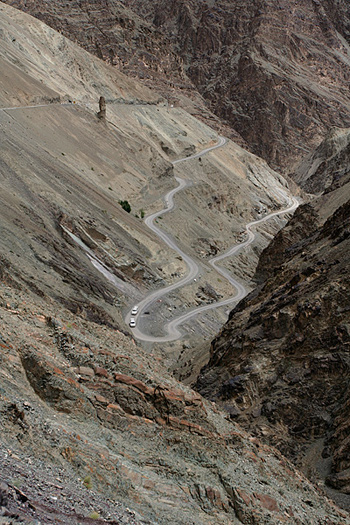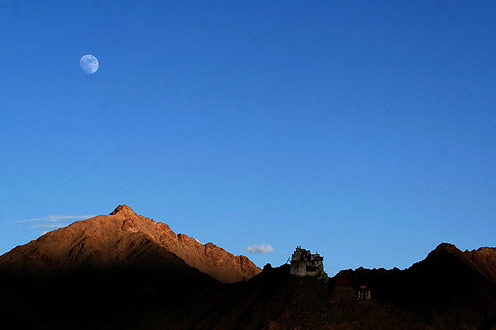Join expedition leader Manish Lakhani on Chadar Trek – January 2012
This is a guest post from an avid traveller Manish Lakhani. Manish lives in Baroda and works in the telecom industry. He has traveled extensively in the Himalayas, including Ladakh and Sikkim. He went on Chadar trek last winter, and hopes to return again in the coming winter.
Chadar Trek is an unusual expedition of walking on ice. The Zanskar River freezes in winter, enabling walking on the ice sheet along the area that is inaccessible in summer. As you can see from pictures, a warm weather can break the ice, forcing the trekkers to climb over the mountains or walk in the frigid water.
Text and Photographs by Manish.

Mighty mountains and clouds that hide Sun on a cold morning before the trek started. We spent two days visiting places around Leh to acclimatize.

Walking on thin ice? Yes, there is no choice. This is part of day to day trek. A small mistake and you are in freezing water. Porters do this like walking in garden… amazing !

A frozen stream! I was thinking how it must have been flowing in summer. Imagine the temperatures required to make it into ice. There are lots of mineral in the ice that make it look colorful in direct sunlight. Nature is amazing isn’t it ?

It was a very hard day on the way back. After lots of snowfall, there was a shiny day. There was alway risk of melted ice and broken Chadar. A wrong step directly takes you into frigid water. The water is deep, and cold enough to take bring death.

During the return.. There was heavy snowfall, and the next day was sunny. Snowfall takes the temperarte up, resulting in in broken Chadar. We were walking in an ice slurry. I walked almost halfday with my wet feet, a horrible experiense. For the entire night, I was trying to dry my shoes near the fire. Yes i would like to experience this again.

Near Neraks camp site which is near Neraks village. We were wating here for 3 days to get clear snow . These goats belonged to a villager who was staying nears camp site. One day, a fine morning few of the villagers came to my tent to say good morning.

Going Home, a late evening. I was very much tired after after hard day. We walked two days’ distance in one, walking between avalanches. But in the evening, we had some hot soup and delicious food.

The amazing flight. Aerial view of Leh-Delhi route on the way back.
Join expedition leader Manish Lakhani on Chadar Trek – January 2011
“Although I had thought myself hard to impress after traveling for decades across the Himalayas, I heard a gasp escape my jaded lips, and realized I was glimpsing a location even more unlikely than that of the Potala Palace in Lhasa, and a temple even older than that wonder of the world. ” – Pico Iyer on Lamayuru, Ladakh.
Going to Ladakh was a long standing dream. Friends would come back from their two-weeks in Ladakh, some on a biking trip and some taking it more leisurely, but everyone returning with loads of praises on the mountain region. The photographs spoke of the landscapes even when people did not say much. Every time I read someone’s stories or saw some pictures of Ladakh as I gallivanted in the cyberspace, the longing would re-appear and linger on. I wished to see the rare landscapes where one can drive for hundreds of kilometers without seeing any habitation. I would sit for hours making plans for the coming summer, letting Ladakh take over my mind.

The roads of Ladakh
Ladakh had no parallels. In there was a lake that stretched more than 100km across two countries at an altitude of more 14,000 feet. It had mountain ranges standing higher than 18,000 feet, where one can simply drive through. There was more than 400 kilometers of arid landscape where not a single soul lived. Surviving there was an ancient Buddhist civilization that was like a little Tibet. It was the shangrila of travellers and an enigma for everyone. Everything I heard about it added to my yearnings.
I made the first serious attempt to travel into Ladakh two years ago. Hauling myself to Manali, the gateway to Ladakh, I could barely wait for the next two days I would be there to make plans and arrange logistics on the long journey to Leh. But Mangal Singh, my contact in Manali and the man whom we trusted to take us through these Trans-Himalayan landscapes had other plans for us. After listening carefully to our plans, knowing about the time we could spare (less than 10 days) and understanding our interests, he laid out a plan that we could not say no to. He suggested that we go to Spiti Valley, which we accepted after listening to his argument. Lahaul and Spiti was an overwhelming experience, but it prolonged my wait to get to Ladakh.
The next year, I came back with plenty of time in hand. I had quit my day-job and was armed with unlimited time. I was going to take it easy, giving Ladakh as much time it needs to explore fully from one end to other. I was back again in Manali. This time the journey would go step by step, stopping anywhere we wished to on the way and taking time just to get across the mountains to Leh.
I did manage to spend the planned two months wandering the mountains of Ladakh, seeing every corner of the region by every possible means. We took a marathon jeep ride lasting more than 12 hours sitting shoulder to shoulder with ten more people. We traveled in buses whose drivers were trained to take the steep and curvy roads with great ease. We took a taxi when nothing else was an option, and rode on bike over the high passes and across the streams. The journey took me through thousand year old monasteries, gigantic brackish lakes, ancient civilizations that persisted through the changing times, high passes and arid landscapes.
The long journey however, started with a long wait at the grimy bus station in Manali, reminiscent of the Indian plains.
To be continued.
I am starting a travelogue series on Ladakh in the coming week, covering nearly all the important places in the region. A few interesting things that happened over the two months I spent, before we begin the series.
Namgyal Tsemo Monastery, Leh, Ladakh
* Arriving in Leh with just Rs.50 in hand close to midnight. The taxi driver wants Rs.150 to take us to the guesthouse. Take us through an ATM, we tell him. The first ATM we visit is not working, and so is the second. They are the only ATMs in town. We get dropped off anyway, and he collects the money next afternoon. Yes, thankfully one of the ATMs started working next morning or we would not know what to do.
* On the way up to Khardungla on public transport, a lady suddenly gets hysteric. First, it seemed like a terrible case of sneezing with some strange accent built on it! She went on for a long time. Her face looked terrible, her body shook and her hands had came together and vibrated badly. I thought she had suddenly gone sick and unable to bear the pain. But the women sitting next to her, probably her companions, appeared calm. The driver continued driving, climbing higher. She stopped as soon as the bus got to Khardungla. It turns out, she was praying.
* On the way to Lamayuru from Leh, the bus stops early in the morning, thanks to heavy rains that have caused a landslide. A bridge has broken down a little ahead, as a small stream has turned into a raging torrent that is consuming everything on its way. Not knowing what to do, we decide to wait and watch. We walked into a restaurant nearby for some breakfast. But they don’t have much to offer. There is no water because it is raining, tells the man who is attending the place. It took some time for me to understand what he meant. No water because of the rains? Ladakhis rely on their streams for their potable water. The stream was running muddy and violent today, depriving people of their source of clean water.
* We are crossing a stream on a mighty Bullet Thunderbird that weighs more than thrice as much as I weigh. There is no bridge or even an easy section of the stream to wade past. It is full of rocks, and the way is all ups and downs. We are stuck halfway and the bike refuses to go forward how much ever I accelerate. And it keeps getting turned off every minute as soon as I try to accelerate hard. We are stuck. The crazy stream, just about a feet high water, is known to raise to chest level with progress of the day. Are we going to have to let the bike drown here, or even worse, let it get carried away with the force of the water? We must have spent more than thirty minutes struggling get the bike out.
* Entertaining road signs from the creative folks at BRO. “Gati yane durgati”, “Life is short, don’t make it shorter”
* We are on the long bus ride to Zanskar that takes two days. The bus stops at everyone’s request on the way, even if a passengers or two intend to have a long chat with someone in a village on the way. Sometime in later half of the second day, a stop takes really long. As the minutes go by, more and more people get down for a walk, or to figure out what is going on. Some people from the bus are bartering their stuff with Yak’s curd at the village. And a tasting session also follows. Most people in the bus are now out to get their share. And a little later, someone comes into the bus with a container full of it, and distributes a little to everyone. Fifteen minutes of fun.
* After six days of walking in Zanskar, we meet our big challenge. An icy stream that we don’t want to cross. It is muddy and flowing fast, so we don’t know how deep is it, and if we can risk it. Our horseman cum guide – Brij Lal – urges us to go forward. But we wait for him to show us the way. Let’s cross behind him, we decide. He lets the horses go first, the beasts have absolutely no trouble. As the last of the horses is about to leave, something we never expected happens. Brij Lal jumps over one of the last horse, not really sitting on it but hanging behind and holding to the ropes tied on the horse. Before know what is happening, he has crossed to the other side safe and dry. And we are left wondering what to do!
It was a very exciting trip. I can’t to wait to share the stories!









